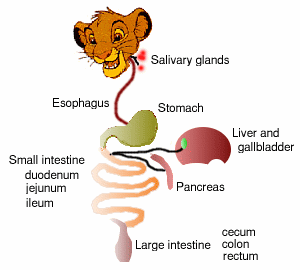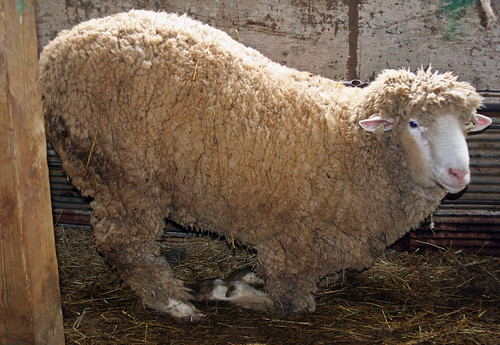I have been asked by my lecturer during oral vet med examination few weeks ago. I remember her asking about cat digestive system. Her question was
" How long the food retain in the digestive tract until it'll be secreted out?"
My answer were simple: "24 hours..maybe?.." (actually i wasnt sure if that was the correct answer)
Then she gave me a long sharp look that almost kills my gaze and says;
"WRONG.."
Here we go..
**********************************************************
Feline digestive system
Cats are true carnivores. Their digestive system plays two important roles: it breaks down food into nutrients that the cat's body can readily absorb, and it also acts as a protective barrier against harmful bacteria and other pathogens (disease causing agents) that the cat may ingest.
The digestive system includes
Mouth
Teeth
Esophagus and stomach
Small and large intestine
Pancreas
Liver
Gross anatomy of cat's digestive system
1. Diaphragm
The muscle which expands and contracts in order to allow the cat to breathe. It separates the thoracic and abdominal cavities
2. Gallbladder
The gallbladder stores bile until it is needed by the small intestine in order to digest fats. The gallbladder is not essential to the process of digestion. It is possible for bile to be delivered directly from the liver to the small intestine. Bile digests and absorbs fat and helps to dispose of waste from the cat's body.
3. Liver
The liver produces many substances in order to digest food. It manufactures bile, which is then stored in the gall bladder. Bile contains acids as well as cholesterol. The liver also stores and releases a compound called glycogen, which is a carbohydrate that can be changed into sugar should the sugar level of the cat fall.
4. Pancreas
The pancreas secretes three compounds. The first compound is a digestive enzyme that helps break down fats and proteins. The second compound is insulin, which regulates the sugar level in the cat's body. The third is a bicorbonate ion that nutralizes stomach acid
5. Peritoneum (not part of GIT)
The peritoneum is the thin membrane that covers the abdominal digestive organs of the cat.
6. Small intestine
The small intestine carries out the final stages in digestion. It is lined with small hairs and blood vessels inside the intestine carry away nutrients to other parts of the cat's body. The small intestine has three sections: the duodenum, the jejunum, and the ileum. The duodenum is the section where the process of absorption begins. The jejunum is the largest portion of the small intestine and it is here where most of the absorption takes place. The ileum is the final section of the intestine and it is where the absorption process ends.
7. Spleen (not part of digestive)
The spleen produces red blood cells and regulates the supply of red blood cells. It also functions as a storage area for blood.
8. Stomach
The stomach stores food while it goes through the initial phases of digestion.
The arrangment of feline digestive
How does the digestion begins?
Humans and Cats are similar in their digestive process in the sense that when food enters the mouth large amounts of saliva are secreted. The saliva will lubricate, dissolve, and chemically break down the food. As a cat takes food into its mouth, it chews it into small pieces. The tongue will assist moving the food to its oral pharynx, the hollow structure at the back of its oral cavity. From there, the food is swallowed, passing into the esophagus--a tube that travels down through the animal's chest and opens into its stomach.
Within the stomach, the ingested food mixes with potent acids and enzymes that are produced by the stomach lining. Feline gastric juices are more powerful than those of a human; they are, in fact, strong enough to soften bone. Cats can swallow large chunks of prey creatures (rodents and birds) and any parts such as feathers, hair and bones that are not quickly broken down in the stomach may be regurgitated.
Once the food passes through the stomach, it then moves through the pylorus, a sphincter, or ringlike muscle, that constricts or relaxes as needed to control flow into the first section of the small intestine (duodenum). This is where most of the digestion takes place. There the food mixes with bile, a bitter yellowish liquid secreted by the liver, the largest organ in a cat, and with a fluid produced by the pancreas. These substances and their enzymes play a key role in neutralizing the harsh stomach acids and breaking down proteins, fats and carbohydrates so that they can be absorbed through the intestinal lining (mucosa) and into the cat's bloodstream. The liver also purifies toxins that have entered the system and recycles dead red blood cells.
From the small intestine, the food passes into the large intestine, which absorbs additional nutrients and also a substantial amount of the water remaining in the ingested food. The large intestine serves as a storage area for the solid material that is left over after the digestive process. This material--the feces--is eventually excreted from the cat's body, through its rectum and anus.
This process normally takes about 20 hours in an adult cat.
Get the answer?
Here something I found on the web about feline nutrition requirements
For adult maintenance
Unless otherwise listed, all values are minimum requirements:
Protein... 26%
Fat ...... 9%
Calcium.... 0.6%
Phosphorus... 0.5%
Potassium... 0.6%
Sodium..... 0.2%
Chloride.... 0.3%
Magnesium... 0.04%
Iron... 80 mg/kg
Copper... 5 mg/kg
Manganese.... 7.5 mg/kg
Zinc....... 75 mg/kg (maximum 2000 mg/kg)
Iodine..... 0.35 mg/kg
Selenium.... 0.1 mg/kg
Vitamin A... 5000 IU/kg (maximum 750,000 IU/kg)
Vitamin D... 500 IU/kg (maximum 10,000 IU/kg)
Vitamin E... 30 IU/kg
Thiamine... 5 mg/kg
Riboflavin... 4 mg/kg
Pantothenic Acid... 5 mg/kg
Niacin... 60 mg/kg
Pyridoxine... 4 mg/kg
Folic Acid....0.8 mg/kg
Vitamin B12...0.022 mg/kg
Choline..... 2400 mg/kg
Taurine... 0.1%
For Growing Kittens, Pregnant and Lactating Queens
The majority of nutrient minimums are the same except for the items listed. The maximum for those listed does not change.
Protein...30%
Calcium 1%
Phosphorus 0.8%
Magnesium... 0.08%
Copper... 5-15 mg/kg
Vitamin A... 9000 IU/kg
Vitamin D... 750 IU/kg
I'll post about feline nutrition later.
Sources: How the cat's digestion works; examiner.com, Dietary requirements in cat petplace.com, Digestive system of the cat, Washington state university































































